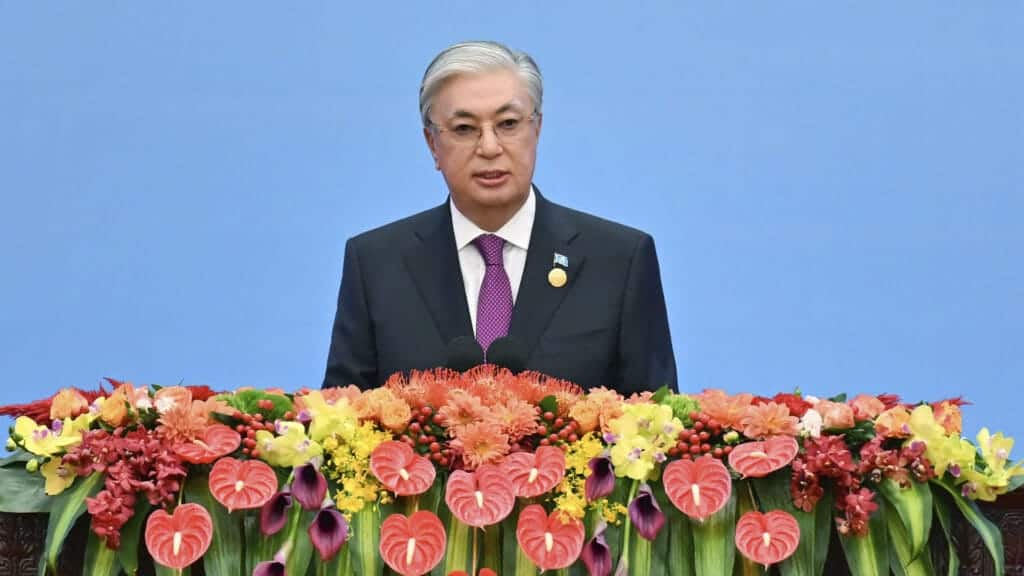Tokayev improves his assessment of Kazakhstan’s role in global logistics

President Kassym-Jomart Tokayev of Kazakhstan has improved his assessment of the volume of land transit from China to Europe through the country’s territory by 5%. Four months ago, in June, he estimated the volume of cargo passing through Kazakhstan at 80%. Now, he has raised his estimate to 85%.
On October 18, at the opening ceremony of the third Belt and Road Initiative summit in Beijing, President Tokayev said that «currently Kazakhstan accounts for 85% of all land transit traffic from China to Europe.»
In June, Tokayev met with President Frank-Walter Steinmeier of Germany. During discussions on cooperation within the Trans-Caspian International Transport Route (TITR), which stretches from China to Europe through Kazakhstan, the Caspian Sea, Azerbaijan, Georgia, Turkey and the Black Sea, he announced a different figure.
«Kazakhstan accounts for 80% of land transit on the route from China to Europe. Last year, about 1.7 million tons of cargo was transported along this route (TITR), which is twice as much as in 2021,» he highlighted at the time.
Kazakhstan and China to create a partnership network of ports and hubs
During the international cooperation summit in Beijing, Tokayev said over the past 15 years, Kazakhstan has spent more than $35 billion to facilitate transit traffic. He also underlined that Kazakhstan is making «serious efforts» to become a vital global transport and logistics hub.
«We have already launched such massive infrastructure projects as the Kazakh-Chinese logistics center in Lianyungang, the Khorgos dry port, the transit highway from Western Europe to Western China and the railway corridor from China to Iran. Now, in the coming three years, we are going to build 1,300 kilometers of new railways, open the third railway checkpoint on the border with China and build new dry ports Bakhty and Kalzhat,» the president said.
Tokayev also recalled that the first official announcement of the Belt and Road Initiative by President Xi Jinping happened ten years ago in Kazakhstan. Over the years, the initiative has become a grandiose international project, according to Kazakhstan’s leader.
«Thanks to the investments by member states of the initiative, more than 150 countries in Asia, Europe and Africa are connected by an extensive network of railways, high-speed highways and sea routes. The project has become a common good for our states, which can now effectively deal with the most complex challenges of our time even amid the extraordinary turbulence in the global economy,» Tokayev emphasized.
He pointed out that the TITR is capable of becoming a continental bridge for the Belt and Road Initiative as it is twice as fast as other routes and significantly cheaper. Tokayev proposed China create a partnership network of key ports, logistics centers and postal hubs and establish joint production of transport ships and containers.
«Kazakhstan is ready to become a reliable air bridge and a convenient harbor for the world’s leading airlines, providing steady traffic of passengers and cargo,» he added.
The Kursiv edition asked Kazakhstan’s Ministry of Transport to clarify how Kazakhstan is going to attract leading airlines and what it is ready to offer them. Last week, the ministry said that the transit potential of Kazakhstan’s airports is constrained by low ticket prices, old equipment and lack of jet fuel. As market participants told Kursiv this summer, tariffs for airport services haven’t been raised for 20 years, while the high cost of jet fuel prevents foreign carriers from entering the market. As a result, the industry is losing qualified workers and suffering from a lack of attention.
What is the future of the TITR?
On October 17, Kazakhstan and China signed agreements aimed at the further development of the TITR. For example, the two countries are going to establish a special Kazakhstani-Chinese contact group; build a railway from Ayagoz to Tacheng; open a third railway crossing point between Kazakhstan and China and build new terminals in the border area. The Ministry of Transport expects that once the third railway crossing point is fully operated, the volume of cargo traffic will rise from 28 million tons to 50 million.
In November 2022, Kazakhstan, Azerbaijan, Georgia and Turkey agreed to simultaneously eliminate all bottlenecks at the TITR and put efforts aimed at its development until 2027. At the time, they signed a special roadmap, which was finalized in August 2023. The interested parties have already established a joint venture that must deal with tariff policy, cargo handling and simplification of transport processes along the route. The government of Kazakhstan says that thanks to all of this, the transit of cargo from China to Europe and back to China will be reduced to 10 to 15 days.
Kazakhstan’s concept for the development of its transport and logistics potential predicts that the TITR will account for up to 20 million tons of transit traffic in seven years. By 2030, the route’s capacity is expected to rise by ten times. For instance, over the first six months of this year, the volume of cargo on the TITR exceeded 1.3 million tons, a 77.2% increase compared to the same period last year, according to Kazakhstan Railways.
President Xi brought up the concept of the New Silk Road called the Belt and Road Initiative in 2013. Under this project, China has been trying to create a massive network of infrastructure like railways and highways, sea and air routes, pipelines and power grid from its western borders to Europe through Central Asia and Iran.

